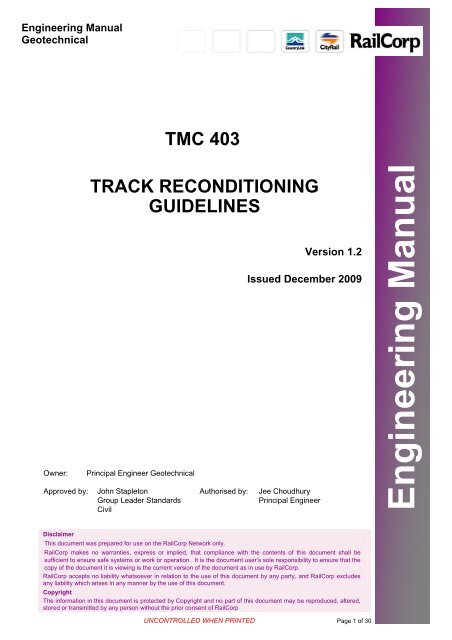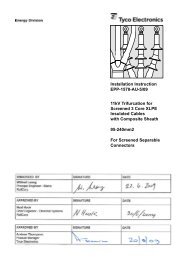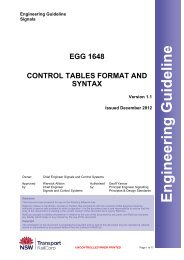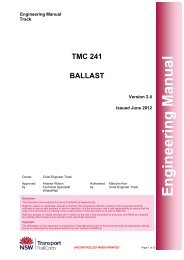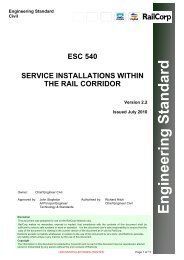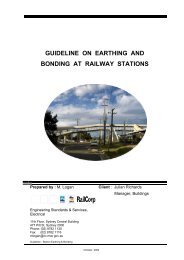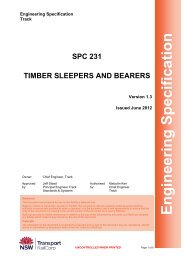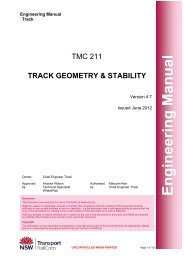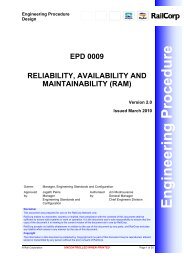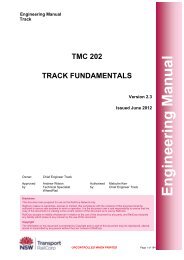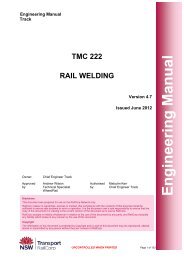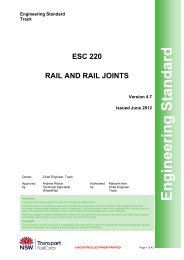tmc 403 track reconditioning guidelines - RailCorp Engineering ...
tmc 403 track reconditioning guidelines - RailCorp Engineering ...
tmc 403 track reconditioning guidelines - RailCorp Engineering ...
You also want an ePaper? Increase the reach of your titles
YUMPU automatically turns print PDFs into web optimized ePapers that Google loves.
<strong>Engineering</strong> Manual<br />
Geotechnical<br />
Owner: Principal Engineer Geotechnical<br />
Approved by: John Stapleton<br />
Group Leader Standards<br />
Civil<br />
TMC <strong>403</strong><br />
TRACK RECONDITIONING<br />
GUIDELINES<br />
Authorised by: Jee Choudhury<br />
Principal Engineer<br />
Version 1.2<br />
Issued December 2009<br />
Disclaimer<br />
This document was prepared for use on the <strong>RailCorp</strong> Network only.<br />
<strong>RailCorp</strong> makes no warranties, express or implied, that compliance with the contents of this document shall be<br />
sufficient to ensure safe systems or work or operation. It is the document user’s sole responsibility to ensure that the<br />
copy of the document it is viewing is the current version of the document as in use by <strong>RailCorp</strong>.<br />
<strong>RailCorp</strong> accepts no liability whatsoever in relation to the use of this document by any party, and <strong>RailCorp</strong> excludes<br />
any liability which arises in any manner by the use of this document.<br />
Copyright<br />
The information in this document is protected by Copyright and no part of this document may be reproduced, altered,<br />
stored or transmitted by any person without the prior consent of <strong>RailCorp</strong><br />
UNCONTROLLED WHEN PRINTED Page 1 of 30<br />
<strong>Engineering</strong> Manual
<strong>RailCorp</strong> <strong>Engineering</strong> Manual — Geotechnical<br />
Track Reconditioning Guidelines TMC <strong>403</strong><br />
Document control<br />
Revision Date of Approval Summary of change<br />
1.2 December 2009 Changes detailed in chapter revisions<br />
1.1 October 2007 C2-2 “Health & Safety” deleted<br />
1.0 October 2006 First issue as a <strong>RailCorp</strong> document. Replaces RTS 3430<br />
Summary of changes from previous version<br />
Chapter Current Revision Summary of change<br />
Control<br />
pages<br />
1.1 Change of format for front page, change history and table of<br />
contents<br />
1 1.1 Format change only<br />
2 1.1 Format change only<br />
3 1.1 Format change only<br />
4 1.1 Format change only<br />
5 1.1 Format change only<br />
6 1.1 Format change only<br />
7 1.1 Format change only<br />
8 1.1 Format change only<br />
9 1.1 Format change only<br />
10 1.1 Format change only<br />
11 1.1 Format change only<br />
12 1.1 Format change only<br />
13 1.1 Format change only<br />
Appendix 1 1.1 Format change only<br />
© Rail Corporation Page 2 of 30<br />
Issued December 2009 UNCONTROLLED WHEN PRINTED Version 1.2
<strong>RailCorp</strong> <strong>Engineering</strong> Manual — Geotechnical<br />
Track Reconditioning Guidelines TMC <strong>403</strong><br />
Contents<br />
Chapter 1 Introduction to Manual ............................................................................................................. 4<br />
C1-1 Purpose....................................................................................................................................... 4<br />
C1-2 How to read the Manual.............................................................................................................. 4<br />
C1-3 References.................................................................................................................................. 4<br />
C1-4 Definitions, abbreviations and acronyms ....................................................................................4<br />
Chapter 2 General Requirements.............................................................................................................. 5<br />
C2-1 Competencies ............................................................................................................................. 5<br />
Chapter 3 Purpose of Track Reconditioning ........................................................................................... 6<br />
Chapter 4 Determining the need to carry out <strong>reconditioning</strong> ................................................................ 7<br />
C4-1 Formation drainage option........................................................................................................ 11<br />
C4-2 Skim <strong>reconditioning</strong>................................................................................................................... 11<br />
Chapter 5 Investigations Prior to Track Reconditioning ...................................................................... 12<br />
C5-1 Investigation Procedures .......................................................................................................... 12<br />
Chapter 6 Track Formation Design......................................................................................................... 14<br />
C6-1 Basic design model................................................................................................................... 14<br />
C6-2 Ballast depth ............................................................................................................................. 15<br />
Chapter 7 Capping Materials ................................................................................................................... 16<br />
C7-1 General ..................................................................................................................................... 16<br />
C7-2 Flexible impermeable Capping .................................................................................................16<br />
C7-3 Sub-ballast ................................................................................................................................ 16<br />
C7-4 Semi-Rigid Capping .................................................................................................................. 16<br />
Chapter 8 Drainage................................................................................................................................... 18<br />
Chapter 9 Geosynthetics ......................................................................................................................... 19<br />
C9-1 Ballast/capping Separation ....................................................................................................... 19<br />
C9-2 Filtration .................................................................................................................................... 20<br />
C9-3 Reinforcement........................................................................................................................... 20<br />
C9-4 Properties of geotextiles in <strong>track</strong> projects .................................................................................21<br />
Chapter 10 Track Reconstruction Solutions............................................................................................ 22<br />
C10-1 Reconstruction by structural fill methods ..................................................................................22<br />
C10-2 Reconstruction using reinforcements of rock fill and geosynthetics......................................... 22<br />
Chapter 11 Chemical Stabilisation............................................................................................................ 25<br />
Chapter 12 Construction Issues ............................................................................................................... 26<br />
Chapter 13 Rock Foundation..................................................................................................................... 27<br />
C13-1 Foundation Rock Pumping........................................................................................................27<br />
C13-2 Irregular Rock Excavation......................................................................................................... 28<br />
Appendix 1 Dynamic Cone Penetrometer (DCP) - Guide to use and interpretation............................. 29<br />
© Rail Corporation Page 3 of 30<br />
Issued December 2009 UNCONTROLLED WHEN PRINTED Version 1.2
<strong>RailCorp</strong> <strong>Engineering</strong> Manual — Geotechnical<br />
Track Reconditioning Guidelines TMC <strong>403</strong><br />
Chapter 1 Introduction to Manual<br />
C1-1 Purpose<br />
This guide has been prepared to assist in the investigation, design and rehabilitation of the existing<br />
<strong>track</strong> formation and ballast.<br />
It is intended to be used in all construction or maintenance activities aimed at modifying the existing<br />
formation conditions.<br />
C1-2 How to read the Manual<br />
C1-3 References<br />
When you read this manual, you will not need to refer to <strong>RailCorp</strong> <strong>Engineering</strong> Standards. Any<br />
requirements from standards have been included in the sections of the manual and shown in<br />
italics.<br />
Reference is however made to other Manuals.<br />
AS 3706 Geotextiles – Methods of test<br />
ESC 240 Ballast<br />
SPC 411 Earthworks Materials Specification<br />
TMC 411 Earthworks Manual<br />
TMC 421 Track Drainage Manual<br />
C1-4 Definitions, abbreviations and acronyms<br />
CBR: Soaked California Bearing Ratio, Standard Compaction.<br />
DCP: Dynamic cone penetrometer<br />
© Rail Corporation Page 4 of 30<br />
Issued December 2009 UNCONTROLLED WHEN PRINTED Version 1.2
<strong>RailCorp</strong> <strong>Engineering</strong> Manual — Geotechnical<br />
Track Reconditioning Guidelines TMC <strong>403</strong><br />
Chapter 2 General Requirements<br />
C2-1 Competencies<br />
It is recommended that a geotechnical engineer experienced in <strong>track</strong> geotechnology authorise the<br />
formation design.<br />
Track <strong>reconditioning</strong> work may only be undertaken by persons with the following competencies:<br />
− TDT X14 – Undertake rail earthworks<br />
− TDT X03 – Undertake <strong>track</strong> ballast activity.<br />
Certification of the <strong>track</strong> during or after work has been completed may only be undertaken by<br />
persons with the following competency:<br />
− TDT B38 01A - Maintain <strong>track</strong> geometry.<br />
© Rail Corporation Page 5 of 30<br />
Issued December 2009 UNCONTROLLED WHEN PRINTED Version 1.2
<strong>RailCorp</strong> <strong>Engineering</strong> Manual — Geotechnical<br />
Track Reconditioning Guidelines TMC <strong>403</strong><br />
Chapter 3 Purpose of Track Reconditioning<br />
The purpose of <strong>track</strong> <strong>reconditioning</strong> is to reconstruct the <strong>track</strong> formation and ballast to restore the<br />
<strong>track</strong> structure to a standard appropriate to current <strong>track</strong> loading. Reconditioning usually involves<br />
the removal of rails, sleepers and ballast and a predetermined depth of the existing formation and<br />
the reconstruction of those components to current earthworks standards. Modifications to the <strong>track</strong><br />
drainage are usually necessary at the same time.<br />
Reconditioning is usually carried out because of bearing capacity failure of the formation or a<br />
failure of the drainage, but is at times carried out to replace foul ballast where local conditions<br />
prevent the use of ballast cleaners.<br />
© Rail Corporation Page 6 of 30<br />
Issued December 2009 UNCONTROLLED WHEN PRINTED Version 1.2
<strong>RailCorp</strong> <strong>Engineering</strong> Manual — Geotechnical<br />
Track Reconditioning Guidelines TMC <strong>403</strong><br />
Chapter 4 Determining the need to carry out <strong>reconditioning</strong><br />
Track improvement requires an adequate investigation. It is important to have a clear idea of what<br />
the problem is, and its extent.<br />
Consideration of the need to carry out <strong>track</strong> <strong>reconditioning</strong> should be given when any one of the<br />
following features exist:<br />
− Continued poor <strong>track</strong> performance i.e. rapid deterioration of top, or top and line in spite of<br />
repeated attempts at resurfacing, ballasting, or ballast cleaning.<br />
− Visible signs of formation failure i.e. “heaving” beyond the ends of sleepers or between<br />
sleepers.<br />
− “Bog Holes” - Track and ballast fouled and/or with mud actively pumping through the ballast.<br />
When the <strong>track</strong> is removed and formation lowered to increase height clearances, the correct ballast<br />
depth must be provided and the reconstruction of the lowered formation should follow the<br />
investigation and design principles set out in this guide.<br />
Figures 1, 2, 3, 4, 5, 6 and 7 illustrate examples of <strong>track</strong> formation problems<br />
Figure 1<br />
© Rail Corporation Page 7 of 30<br />
Issued December 2009 UNCONTROLLED WHEN PRINTED Version 1.2
<strong>RailCorp</strong> <strong>Engineering</strong> Manual — Geotechnical<br />
Track Reconditioning Guidelines TMC <strong>403</strong><br />
Figure 2<br />
Figure 3<br />
© Rail Corporation Page 8 of 30<br />
Issued December 2009 UNCONTROLLED WHEN PRINTED Version 1.2
<strong>RailCorp</strong> <strong>Engineering</strong> Manual — Geotechnical<br />
Track Reconditioning Guidelines TMC <strong>403</strong><br />
Figure 4<br />
Figure 5<br />
© Rail Corporation Page 9 of 30<br />
Issued December 2009 UNCONTROLLED WHEN PRINTED Version 1.2
<strong>RailCorp</strong> <strong>Engineering</strong> Manual — Geotechnical<br />
Track Reconditioning Guidelines TMC <strong>403</strong><br />
Figure 6<br />
Figure 7<br />
Some of the above problems can be solved without removal of the <strong>track</strong>.<br />
Reconditioning, however, IS required when the foundation has failed.<br />
© Rail Corporation Page 10 of 30<br />
Issued December 2009 UNCONTROLLED WHEN PRINTED Version 1.2
<strong>RailCorp</strong> <strong>Engineering</strong> Manual — Geotechnical<br />
Track Reconditioning Guidelines TMC <strong>403</strong><br />
Alternatives that can be considered include:<br />
Methods that do not require <strong>track</strong> removal:<br />
− Shoulder and crib ballast replacement (manual and machine)<br />
− Cross Drains (See Section C4-1)<br />
− Sledding<br />
− Ballast Cleaning<br />
− Lime slurry injection<br />
Methods that require <strong>track</strong> removal:<br />
− “Skim” Reconditioning (See Section C4-2)<br />
− Formation reconstruction<br />
C4-1 Formation drainage option<br />
Track conditions may improve sufficiently without <strong>reconditioning</strong> if drainage of the formation is<br />
improved. Cut-off drains across the whole <strong>track</strong> to a level below the ballast formation interface will<br />
drain depressions in the formation. These cut off drains or finger drains need to be at intervals of<br />
5m. This solution may avoid costly <strong>track</strong> possession.<br />
Removal of the shoulder ballast and replacement with clean ballast will release water trapped in<br />
the <strong>track</strong> profile, and replacement of the crib ballast with clean ballast will improve <strong>track</strong><br />
performance.<br />
Cess drains must be lowered to below the formation level to permit drainage.<br />
C4-2 Skim <strong>reconditioning</strong><br />
Where the formation has not failed, there is no original capping, and it is possible to raise the <strong>track</strong>,<br />
skim <strong>reconditioning</strong> is a viable solution.<br />
The <strong>track</strong> is removed and the clean top ballast excavated. The foul bottom ballast is graded and<br />
compacted to form a structural capping layer. The <strong>track</strong> is then relaid and ballasted.<br />
This method is used when replacing timber sleepers with concrete sleepers.<br />
© Rail Corporation Page 11 of 30<br />
Issued December 2009 UNCONTROLLED WHEN PRINTED Version 1.2
<strong>RailCorp</strong> <strong>Engineering</strong> Manual — Geotechnical<br />
Track Reconditioning Guidelines TMC <strong>403</strong><br />
Chapter 5 Investigations Prior to Track Reconditioning<br />
The causes of <strong>track</strong> formation failure and details of the subsurface conditions should not be<br />
assumed. All <strong>reconditioning</strong> projects should have a geotechnical investigation carried out by an<br />
experienced geotechnical engineer at the early planning stage.<br />
The geotechnical investigation should consider the following:<br />
− Subsurface conditions – depth and condition of ballast, capping and subgrade<br />
− Determination of the cause of failure – foundation failure, ineffective drainage, rock pumping<br />
− Adjoining structures – effect on platform or other footings, if any<br />
− Reconditioning recommendations – ballast clean, skim (remove ballast only) or full<br />
<strong>reconditioning</strong><br />
− Reconditioning design – depth of layers etc<br />
− Subgrade treatment – geosynthetics, rock fill, geocell etc<br />
− Drainage needs.<br />
C5-1 Investigation Procedures<br />
The investigation of a <strong>track</strong> constructed on clay or fill shall consist of the following:<br />
1. Excavation of test pits at regular intervals (10 to 20m, alternate Up & Down Side, in the four<br />
foot, and at obviously failed locations) to determine:<br />
∼ the depth and condition of the ballast;<br />
∼ the existence of other ballast materials;<br />
∼ the existence and condition of capping;<br />
∼ the condition and type of subgrade;<br />
∼ the degree of saturation of all materials;<br />
∼ information about the interface profile, if visible, to indicate the degree of rutting or<br />
consolidation.<br />
Investigations should be located between two sleepers and the outside rail or in the 4 foot and<br />
extend to below the formation level or about 1.2m below the rail level. See Figure 8.<br />
Excavations across the whole <strong>track</strong> between sleepers provide the most information, especially<br />
about the formation profile, but are expensive and intrusive and should be done less frequently<br />
as a control.<br />
2. Insitu strength tests using Dynamic Cone Penetrometer (DCP) should be conducted close to<br />
the rail. Tests should start from below the ballast and continue to a depth of 2.5m below rail<br />
level to provide an estimate of the insitu CBR value.<br />
3. Samples of the subgrade should be selected for classification testing and to assist in the<br />
design of graded filters (sub-ballast) or geotextiles or to determine if stabilising materials will<br />
assist in improving subgrade performance. Samples of the top and bottom ballast should be<br />
taken to determine ballast recovery, should the material be recycled. Samples should be a<br />
minimum of 30kg in size.<br />
4. A description of the degree of saturation of the <strong>track</strong> should be recorded, as should details of<br />
the cess drainage and any existing systems, and an evaluation of its condition should be<br />
undertaken.<br />
5. Survey details of the <strong>track</strong>, cess drain inverts, culvert inverts and adjacent areas, (and beyond<br />
boundary if necessary) are necessary for the design of future drainage.<br />
© Rail Corporation Page 12 of 30<br />
Issued December 2009 UNCONTROLLED WHEN PRINTED Version 1.2
<strong>RailCorp</strong> <strong>Engineering</strong> Manual — Geotechnical<br />
Track Reconditioning Guidelines TMC <strong>403</strong><br />
Excavation in<br />
four foot or<br />
outside rail<br />
Formation – type of<br />
material, moisture<br />
condition, hard/soft?<br />
Ballast<br />
Foul Ballast?<br />
(Wet/moist/dry, fouling<br />
material, ballast type)<br />
Capping? – wet/moist? condition?<br />
DCP Test<br />
from top of capping to<br />
2.5m below rail level<br />
Subgrade Condition?<br />
Figure 8 – Ballast depth and formation investigation for <strong>reconditioning</strong><br />
© Rail Corporation Page 13 of 30<br />
Issued December 2009 UNCONTROLLED WHEN PRINTED Version 1.2
<strong>RailCorp</strong> <strong>Engineering</strong> Manual — Geotechnical<br />
Track Reconditioning Guidelines TMC <strong>403</strong><br />
Chapter 6 Track Formation Design<br />
C6-1 Basic design model<br />
The basic design model consists of the standard 300 mm of ballast below the sleeper supported by<br />
150 mm of capping material. This is satisfactory provided the underlying material will provide<br />
sufficient support (Refer to C6-2).<br />
Where the formation consists of hard rock or concrete the ballast thickness must not be less than<br />
250mm otherwise ballast degradation and rock abrasion will accelerate (Refer to C6-2).<br />
For <strong>track</strong> on soil or fill, the material immediately beneath the capping layer (structural fill) is required<br />
to have a soaked Californian Bearing Ratio (CBR) ≥ 8. (See Figure 9). The required thickness of<br />
this material varies depending on the quality of the founding material. The thickness “H” of<br />
structural fill/material is recommended for the following founding material:<br />
Founding Material - CBR Thickness “H”(mm) Structural Material<br />
≥ 3 500<br />
1-3 1000<br />
Dynamic Cone Penetrometer (DCP) testing is therefore required to 2.5m below rail. A correlation<br />
between DCP tests and CBR is provided in Appendix 1.<br />
1<br />
1.5<br />
H=500 to 1000mm<br />
1:30<br />
150mm thick<br />
Base of excavation H=500 if insitu material CBR=3 to 8<br />
H=1000 if insitu material CBR=1 to 3<br />
For insitu material CBR8 Compacted to 100%<br />
Standard Compaction<br />
Figure 9 – Track Formation - Basic Design Model<br />
© Rail Corporation Page 14 of 30<br />
Issued December 2009 UNCONTROLLED WHEN PRINTED Version 1.2
<strong>RailCorp</strong> <strong>Engineering</strong> Manual — Geotechnical<br />
Track Reconditioning Guidelines TMC <strong>403</strong><br />
C6-2 Ballast depth<br />
The ballast depth criteria are extracted from <strong>RailCorp</strong> Standard ESC 240 “Ballast”.<br />
Ballast depth is the distance from the underside of the sleeper to the top of the finished<br />
formation.<br />
On superelevated <strong>track</strong>, the depth of ballast is measured from under the low rail.<br />
Ballast depth shall be either "High" or "Medium" or "Low" as detailed in the tables below.<br />
Operating Class<br />
Category<br />
Design Ballast depth(mm)<br />
Minimum Maximum<br />
High H 350 500<br />
Medium M 300 500<br />
Low<br />
Sleeper type<br />
L 250 500<br />
L(150) 150 500<br />
L(100) 100 500<br />
L(Nom) Nominal 500<br />
Ballast depth categories<br />
New Existing<br />
Ballast<br />
depth<br />
(Note 3)<br />
Sleeper type<br />
Ballast depth<br />
(Note 1, 2)<br />
Passenger Main Line<br />
Main line<br />
Medium duty concrete<br />
Heavy duty concrete<br />
L Timber L<br />
Mixed Passenger Freight<br />
Main Line<br />
Medium duty concrete<br />
Heavy duty concrete<br />
M Timber M<br />
Light Line NA Timber L<br />
Heavy Freight Option Heavy duty concrete<br />
Sidings<br />
H Heavy duty concrete H<br />
General Yard (1) Medium duty concrete L Timber L(150)<br />
Passenger operations/ or<br />
maintenance<br />
Medium duty concrete L Timber L(150)<br />
Passenger Siding Timber L(100) Timber L(100)<br />
<strong>Engineering</strong> Maintenance<br />
Siding<br />
Timber L(Nom) Timber L(Nom)<br />
Ballast height<br />
Notes:<br />
1: Full ballast depth in existing <strong>track</strong> includes ballast that is not free draining. Free draining ballast<br />
may include ballast with fines such as sand, brake dust and other fine material that does not<br />
restrict water flow.<br />
2: Existing <strong>track</strong> may not necessarily achieve the target ballast depth.<br />
3: Use of the design ballast depths with poor subgrades may still cause the subgrade to be over<br />
stressed. Detailed investigation and analysis of the whole <strong>track</strong> structure including the<br />
substructure condition may be necessary in these problem situations. It can equally be<br />
demonstrated that in areas with very good subgrades (natural or designed) it is possible to<br />
provide adequate support to the <strong>track</strong> structure with lower ballast depths than those<br />
specified above. The design ballast depth is based on the formation design model detailed<br />
in C6-1.<br />
© Rail Corporation Page 15 of 30<br />
Issued December 2009 UNCONTROLLED WHEN PRINTED Version 1.2
<strong>RailCorp</strong> <strong>Engineering</strong> Manual — Geotechnical<br />
Track Reconditioning Guidelines TMC <strong>403</strong><br />
Chapter 7 Capping Materials<br />
C7-1 General<br />
Capping as specified in <strong>RailCorp</strong> specification SPC 411 “Earthworks Materials” is used for some or<br />
all of the following reasons:<br />
− To improve <strong>track</strong> support. (Generally a layer 150 mm thick is sufficient for normal conditions<br />
with increased thickness for soft subgrade).<br />
− To fill in irregular over-break situations in rock excavations to assist in drainage.<br />
− To provide a drainage barrier to shed storm water from subgrade.<br />
The performance of the capping depends on the quality of the material and the quality of its<br />
compaction on placement. The material needs to comply strictly with the requirements of SPC 411<br />
and to be compacted in accordance with manual TMC 411 “Earthworks” to provide the<br />
‘Barrier/Support’ features expected.<br />
C7-2 Flexible impermeable Capping<br />
C7-3 Sub-ballast<br />
The properties specified for capping of this type are designed to provide a flexible impermeable<br />
granular layer of high strength. For this material to perform correctly the properties of the material<br />
supplied must strictly comply with the requirements of SPC 411 for flexible impermeable capping.<br />
This layer is designed to seal the formation and shed any surface water. Material supplied as<br />
DGB20, or similar, in accordance with specifications prepared for the RTA of NSW do not<br />
necessarily comply and will not provide a seal to the formation. The closest road specification to<br />
rail requirements is “Road base for unsealed roads”. Material to be used as capping of this type<br />
should be tested for compliance prior to use.<br />
It is also very important that the correct compaction levels are obtained. Poorly compacted capping<br />
will become saturated quickly, foul the <strong>track</strong> and become the cause of further <strong>track</strong> and ballast<br />
problems.<br />
Where the foundation consists of free draining materials such as rock fill or sand a sub-ballast may<br />
be more appropriate than an impermeable capping.<br />
Sub-ballast is not impermeable and is designed as a filter material to limit fouling by subgrade<br />
material and to prevent itself from fouling the ballast. Its purpose is to:<br />
− Spread vertical load from the ballast.<br />
− Prevent migration of fines from the subgrade.<br />
− Permit migration of moisture.<br />
The grading of the sub-ballast is important and must be specifically designed for a particular<br />
subgrade and ballast. Laboratory testing of both the subgrade and the ballast is required to be<br />
able to design a grading for sub-ballast.<br />
The performance of the sub-ballast is not destroyed by saturation as is that of the capping and it is<br />
much more easily compacted. It may provide a better solution than capping in areas where the<br />
subgrade is constantly wet due to, say, a spring or in soft rock formation situations.<br />
C7-4 Semi-Rigid Capping<br />
In situations where it is difficult to obtain material complying with the specifications for impermeable<br />
capping and the formation conditions are relatively stiff a semi-rigid capping may be appropriate. It<br />
is also appropriate as a capping over soft friable rock foundations. This material may consist of a<br />
stabilised material and properties are specified in SPC 411.<br />
© Rail Corporation Page 16 of 30<br />
Issued December 2009 UNCONTROLLED WHEN PRINTED Version 1.2
<strong>RailCorp</strong> <strong>Engineering</strong> Manual — Geotechnical<br />
Track Reconditioning Guidelines TMC <strong>403</strong><br />
The use of this material over soft formation is not recommended as it will crack on flexure and<br />
rapidly cause <strong>track</strong> pumping problems. It is advised that thorough geotechnical investigation and<br />
analysis be performed before choosing this type of capping.<br />
© Rail Corporation Page 17 of 30<br />
Issued December 2009 UNCONTROLLED WHEN PRINTED Version 1.2
<strong>RailCorp</strong> <strong>Engineering</strong> Manual — Geotechnical<br />
Track Reconditioning Guidelines TMC <strong>403</strong><br />
Chapter 8 Drainage<br />
The success of any <strong>track</strong> or reconstructed <strong>track</strong> formation is governed by the effectiveness of the<br />
drainage of water from the ballast above the capping and of the subsoil water beneath the capping.<br />
An effective surface drainage system must be constructed as part of all <strong>reconditioning</strong>. For surface<br />
drainage to be effective, grades must be uniform, without local hollows. Ponding of water in cess<br />
drains or surface drains produces gradual deterioration of the formation strength.<br />
Reconditioning must not create a condition where water ponds beneath the <strong>track</strong>.<br />
If the investigation discovers saturated conditions a subsoil drainage system must also be installed.<br />
Subsoil drainage is required to:<br />
− Drain any porous subsoil material<br />
− Lower the water table where it is near the ground surface<br />
− Reduce pore water pressure due to train loadings in rock foundations or artesian pressure eg.<br />
- springs.<br />
Subsoil drainage systems require headwalls at the outlets and flushing points for maintenance.<br />
These features need to be clearly visible and signposted.<br />
More detailed information on surface and subsoil drains is available in TMC 421 “Track Drainage”.<br />
© Rail Corporation Page 18 of 30<br />
Issued December 2009 UNCONTROLLED WHEN PRINTED Version 1.2
<strong>RailCorp</strong> <strong>Engineering</strong> Manual — Geotechnical<br />
Track Reconditioning Guidelines TMC <strong>403</strong><br />
Chapter 9 Geosynthetics<br />
CAUTION<br />
Geotextiles are not magic solutions.<br />
They cannot be used to short cut the project<br />
or make up for poor construction materials.<br />
Geotextiles have been used extensively in <strong>track</strong> <strong>reconditioning</strong> for some years because it was<br />
believed that benefit could be gained in subgrade support and separation of the ballast from the<br />
capping. More recent experience and investigations reveal that the geotextile provides little benefit<br />
unless used appropriately and may also create additional problems. The most appropriate uses of<br />
geosynthetics in <strong>track</strong> formation are:<br />
− Filtration and separation.<br />
− Subgrade support.<br />
The geotextiles for these purposes have significantly different properties and the better<br />
performance in one area means a reduced performance in the other.<br />
C9-1 Ballast/capping Separation<br />
Geotextile was originally placed beneath the ballast in the belief that it would reduce fouling of the<br />
ballast by fine material from the formation. In other cases it was placed because the capping had<br />
not been sufficiently compacted. However, research of ballast performance has shown that where<br />
the formation and capping are constructed properly the major contribution to ballast fouling is from<br />
ballast breakdown and contamination from the surface. The presence of geotextile therefore fails<br />
to protect the ballast from these contaminants. Local experience has shown in many cases that<br />
the material above the geotextile has been fouled more than the material below.<br />
Furthermore the geotextile suffers severely from abrasion by the ballast and very quickly loses its<br />
separating capabilities. Where the geotextile has been used in wet and soft conditions or when<br />
capping has not been compacted adequately, the high dynamic loads from rail traffic induces<br />
extreme pressures at the ballast formation interface and the filtering action of the geotextile is<br />
negligible.<br />
Ballast cleaning operations have also been severely hampered by the presence of the geotextile.<br />
It is therefore not recommended that geotextile be placed beneath ballast at the<br />
ballast/capping interface.<br />
A geotextile is, however, necessary between two materials of significantly different grading. When<br />
placing capping or sub ballast material over coarse rock fill a geotextile is necessary to prevent the<br />
fine material of the capping from falling into the voids of the coarse fill.<br />
© Rail Corporation Page 19 of 30<br />
Issued December 2009 UNCONTROLLED WHEN PRINTED Version 1.2
<strong>RailCorp</strong> <strong>Engineering</strong> Manual — Geotechnical<br />
Track Reconditioning Guidelines TMC <strong>403</strong><br />
C9-2 Filtration<br />
Figure 10 – Excavated geotextile showing complete “clogging” in service<br />
Geotextiles are used to great advantage in subsoil drainage systems and the costly process of<br />
graded aggregate filters can be avoided. A geotextile wrapped around coarse aggregate or a<br />
slotted pipe provides substantial cost savings.<br />
It is, however, necessary to sample and test the soils in which the subsoil drain will be placed to<br />
determine the appropriate geotextile to use. Some soils are not filtered by all types of geotextile.<br />
Soils with a high content of fine silts and clays require close investigation and in some cases<br />
cannot be drained by subsoil drains wrapped in geotextile.<br />
The important properties of the geotextile are its filtering properties and the strength properties so<br />
that the geotextile will maintain its integrity during the construction process. The properties set out<br />
in the following tables are for average conditions. Where there is doubt about the soil/geotextile<br />
compatibility, a geotechnical investigation is required.<br />
C9-3 Reinforcement<br />
A geotextile is placed below the structural fill to reduce subgrade deformation due to load and to<br />
reduce the amount of structural fill required. A geotextile for such a purpose is required to have a<br />
high tensile strength and low elongation and to develop good bond with the contact material.<br />
The best material for this purpose is a geogrid and it is recommended in very soft areas. Other<br />
geotextiles that provide good reinforcement are woven type fabrics and bonded fabrics. The<br />
properties recommended as a minimum for <strong>track</strong> work are given in Section 9.4 below.<br />
© Rail Corporation Page 20 of 30<br />
Issued December 2009 UNCONTROLLED WHEN PRINTED Version 1.2
<strong>RailCorp</strong> <strong>Engineering</strong> Manual — Geotechnical<br />
Track Reconditioning Guidelines TMC <strong>403</strong><br />
C9-4 Properties of geotextiles in <strong>track</strong> projects<br />
C9-4.1 Subsoil Drainage<br />
Property Test Method Value<br />
Tearing Strength, Trapezoidal * AS 3706.3 200N min<br />
Burst Strength, CBR Method * AS 3706.4 1700N min<br />
Puncture Resistance, Drop<br />
Cone *<br />
AS 3706.5<br />
Pore Size * AS 3706.7 240 max<br />
d500 = 33.5 mm Max<br />
H50 = 900 mm Min<br />
Permittivity AS 3706.9 3.4 sec + min<br />
* - Important when used as a separation for rock fill<br />
C9-4.2 Subgrade Reinforcement (below capping)<br />
Property Test Method Value<br />
Tensile Strength, wide strip AS 3706.2 25 KN/m min peak<br />
Elongation at peak Strength AS 3706.2 25% max<br />
Burst Strength CBR Method AS 3706.4 2800N min<br />
Permittivity AS 3706.9 0.12 sec -1 min<br />
C9-4.3 Properties of Geogrids<br />
A geogrid is specifically designed to provide tensile reinforcement to the <strong>track</strong> substructure.<br />
Geogrids are superior to geotextiles in this function because of their higher modulus and tensile<br />
strength and their performance is not destroyed by coarse aggregate.<br />
The geogrid selection should be on the basis of the grading of the material in contact with it. The<br />
grid opening size is related to the maximum size of the aggregate with which it interlocks. The<br />
manufacturers provide selection criteria for their products for various uses.<br />
The recommended minimum strength is 20 KN/m transverse and 20 KN/m longitudinal to the <strong>track</strong>.<br />
The interlocking with aggregates is important. When selecting a geogrid, careful attention should<br />
be paid to the profile and rigidity of the grid webbing. A geogrid with a square web profile and high<br />
rigidity will perform well in interlocking with aggregate.<br />
© Rail Corporation Page 21 of 30<br />
Issued December 2009 UNCONTROLLED WHEN PRINTED Version 1.2
<strong>RailCorp</strong> <strong>Engineering</strong> Manual — Geotechnical<br />
Track Reconditioning Guidelines TMC <strong>403</strong><br />
Chapter 10 Track Reconstruction Solutions<br />
Reconditioning is usually required because the subgrade has not met the above criteria. Methods<br />
of improving the performance of the existing subgrade material need to be considered in the<br />
planning of the <strong>reconditioning</strong>. The following options are suggestions only and each situation<br />
needs to be assessed by a geotechnical engineer for conditions particular to the site.<br />
C10-1 Reconstruction by structural fill methods<br />
Reconstruction of the formation is conducted by excavation of unsuitable material and replacement<br />
with suitable material to suit the basic design model. See Figure 9.<br />
For soft subgrade this option would require sufficient time and space to permit the removal and<br />
replacement of what could consist of a substantial amount of material to provide the support<br />
defined in the model.<br />
If, however, investigations indicate that the subgrade has a CBR of 8 or greater and that <strong>track</strong><br />
failure is due to loss of the frictional properties of the ballast due to poor drainage only, minimal<br />
excavation is necessary to remove the thin layer of soft material immediately beneath the ballast.<br />
In conjunction with the necessary reconstruction of effective drainage, a reduced thickness of<br />
structural fill can be used in these situations.<br />
The new material must comply with the requirements of TMC 411 and SPC 411 and the work<br />
required includes preparation and compaction as normally required for earthworks construction. A<br />
capping layer of 150 mm (min) is recommended unless the structural fill also meets the<br />
requirements of SPC 411, in which case the fill would continue to below the ballast.<br />
C10-2 Reconstruction using reinforcements of rock fill and geosynthetics<br />
The use of geotextiles and/or geogrids, geocells and rockfill can assist to reduce the amount of<br />
excavation and fill material especially, in soft subgrade.<br />
C10-2.1 For subgrade with CBR = 3-8<br />
Where the subgrade has been found to have an insitu CBR of between 3 and 8, a geotextile placed<br />
below a higher grade imported fill material will reduce the excavation necessary. The fill material is<br />
recommended to have a CBR of at least 20 at 100% standard compaction and a minimum<br />
thickness of 350 mm. The geotextile reinforcement must be a high strength, low elongation type<br />
material or the benefits will not be realised. See Figure 11.<br />
C10-2.2 For subgrade with CBR = 1-3<br />
1<br />
1m (min)<br />
1.5<br />
1:30<br />
Subgrade CBR = 3 – 8 use Geotextile<br />
Subgrade CBR = 1 – 3 use Geogrid<br />
Capping 150mm (min)<br />
Ballast depth – see C6-2<br />
Figure 11 – Geogrid Reinforcement<br />
© Rail Corporation Page 22 of 30<br />
Issued December 2009 UNCONTROLLED WHEN PRINTED Version 1.2<br />
H<br />
1m (min)<br />
Geotextile<br />
separation<br />
H=350mm, Subgrade CBR = 3 – 8<br />
H=500mm, Subgrade CBR = 1 - 3
<strong>RailCorp</strong> <strong>Engineering</strong> Manual — Geotechnical<br />
Track Reconditioning Guidelines TMC <strong>403</strong><br />
Where the subgrade has been found to have a CBR of between 1 and 3 a geogrid is recommended<br />
in place of a geotextile at the subgrade level. The same recommendations for the type of fill as in<br />
Section 11.3.1 apply with a thickness of 500mm. See Figure 11.<br />
C10-2.3 For Subgrade with CBR = 1 or less (rock fill)<br />
Where the subgrade has been found to have a CBR of 1 or less it will be necessary to use coarse<br />
rock fill to reduce the amount of excavation. A minimum excavation of 500 mm is recommended.<br />
Obtain geotechnical advice on this matter.<br />
Coarse rockfill, 50-150 mm in size (no fine material) is tipped or rolled into the soft material. More<br />
is added until the rock fill no longer penetrates the mud and the surface is just free of mud. A<br />
geogrid is then laid and filling continued with rock fill up to the underside of capping, with<br />
appropriate static rolling. No wheeled or <strong>track</strong>ed machinery should be permitted on the subgrade<br />
until sufficient rockfill has been placed to support it. An additional layer of geogrid should be added<br />
where the filling exceeds 500 mm.<br />
The surface of the rock fill must be covered with a geotextile for separation between rock fill and<br />
capping. See Figure 12.<br />
1<br />
1m (min)<br />
1.5<br />
Rock rolled into soft<br />
formation<br />
1:30<br />
Rockfill<br />
50 to 150mm<br />
static rolled<br />
Capping 150mm (min)<br />
Ballast depth – see C6-2<br />
Subgrade CBR500mm<br />
An alternative to the solutions outlined in 10.2.3 is to install geocells to improve the load support<br />
capacity of soft subgrade. This is often recommended for swampy conditions where the ground<br />
water is close to the surface. Geocells consist of an array of plastic hexagonal cells infilled with<br />
granular material. These are installed immediately below the ballast and filled with ballast.<br />
Geocells are available in panels 2.44m X 6.1m with thickness varying between 102 and 203mm.<br />
The thickness and number of geocell layers must be individually designed for each particular<br />
situation. An excavation is made to the designed level of the geocell base. A geotextile is laid over<br />
the excavation to minimise the transmission of fines through the geocell into the ballast. The<br />
geocell is laid out, filled and the infill lightly compacted. No capping is required above the geocell,<br />
however in situations where the subgrade needs to be protected from surface water, an<br />
impermeable geomembrane may be installed at the geocell base instead of a geotextile.<br />
Impermeable membrane are not required when geocells are installed in swampy ground<br />
conditions. See Figure 13.<br />
© Rail Corporation Page 23 of 30<br />
Issued December 2009 UNCONTROLLED WHEN PRINTED Version 1.2
<strong>RailCorp</strong> <strong>Engineering</strong> Manual — Geotechnical<br />
Track Reconditioning Guidelines TMC <strong>403</strong><br />
1<br />
1.5<br />
Geotextile or Impermeable<br />
geomembrane<br />
1:30<br />
Geocell 100 to 200 deep<br />
Ballast depth – see C6-2<br />
Figure 13 – Geocell Reinforcement, Formation CBR
<strong>RailCorp</strong> <strong>Engineering</strong> Manual — Geotechnical<br />
Track Reconditioning Guidelines TMC <strong>403</strong><br />
Chapter 11 Chemical Stabilisation<br />
Stabilisation of subgrade is the improvement of the subgrade by mixing in lime or injection of lime<br />
or a lime/fly ash mixture.<br />
Lime stabilisation is very relevant for high plasticity clays because of the reaction of lime with the<br />
clay minerals and can be used to reduce the shrink/swell behaviour of active soils. For the best<br />
results the subgrade must be scarified and lime spread and mixed uniformly. This requires<br />
adequate <strong>track</strong> possession and work space.<br />
Lime injection methods require numerous inspection points to guarantee that the lime is uniformly<br />
distributed in the subgrade.<br />
For less plastic clays the effect of lime is not as good. Procedures are available for lime and fly ash<br />
injection that provide an improvement in strength of the subgrade. These procedures provide highpressure<br />
injection to significant depths at close spacing.<br />
In general, lime injection or stabilisation is not recommended without sufficient investigation to<br />
support their use. Geotechnical advice and laboratory testing is necessary to determine the<br />
appropriate percentage of lime for the soil in question.<br />
Stabilisation by the injection of cement slurry is not recommended.<br />
Other chemicals are offered to assist in the stabilisation of the subgrade and need to be evaluated<br />
as to practicability or effectiveness. Obtain geotechnical advice to assist in the evaluation of any<br />
products that are being marketed as possible stabilisation measures.<br />
© Rail Corporation Page 25 of 30<br />
Issued December 2009 UNCONTROLLED WHEN PRINTED Version 1.2
<strong>RailCorp</strong> <strong>Engineering</strong> Manual — Geotechnical<br />
Track Reconditioning Guidelines TMC <strong>403</strong><br />
Chapter 12 Construction Issues<br />
1. Minimise or eliminate construction traffic over exposed subgrade material.<br />
After excavation of the ballast the formation is not usually very firm and the passage of<br />
wheeled or <strong>track</strong>ed machinery will cause significant additional damage.<br />
Where possible, the construction method must be designed to avoid trafficking over the<br />
exposed formation. Excavating spoil by placing excavating machinery on adjacent<br />
undisturbed <strong>track</strong> or ground, and pushing new fill in front of construction equipment is<br />
necessary when dealing with a soft formation. The structure of some clay is destroyed by the<br />
remoulding action of construction equipment. This damage to the soil structure is permanent<br />
and may reduce the material strength and affect the future performance of the formation.<br />
2. Compact new fill in layers no deeper than 200mm when loose. Thinner layers are required for<br />
light compaction equipment.<br />
3. Use proper compaction equipment and compact to the specified density.<br />
4. Construct the correct cross fall.<br />
5. Construct adequate drainage.<br />
© Rail Corporation Page 26 of 30<br />
Issued December 2009 UNCONTROLLED WHEN PRINTED Version 1.2
<strong>RailCorp</strong> <strong>Engineering</strong> Manual — Geotechnical<br />
Track Reconditioning Guidelines TMC <strong>403</strong><br />
Chapter 13 Rock Foundation<br />
The investigation of <strong>track</strong> on a rock base follows the basic steps set out earlier. Where there is<br />
evidence of <strong>track</strong> fouling as a result of foundation problems and the investigation reveals that the<br />
<strong>track</strong> is constructed on hard shale or sandstone, the potential of foundation rock pumping must also<br />
be investigated by a geotechnical engineer.<br />
C13-1 Foundation Rock Pumping.<br />
Foundation rock pumping occurs in horizontally bedded rock under <strong>track</strong> work where the cyclic<br />
loading conditions cause deflections of the rock strata and abrasion along rock bedding planes. In<br />
the presence of water, fine material, resulting from the abrasive action, is forced through fractures<br />
in the rock and contaminates the ballast. Depending on drainage conditions at the <strong>track</strong> level,<br />
isolated cones of rock fines will exist in the ballast or the ballast will eventually be completely fouled<br />
with fines. See Figure 14.<br />
Pumping can occur up to 2.0m below the <strong>track</strong> formation level.<br />
In cases where foundation rock pumping is believed to be occurring more detailed investigation of<br />
the rock strata is required and diamond drill coring investigation methods are recommended, with a<br />
geological evaluation of whatever rock is exposed in adjacent cuttings. The cores should be<br />
examined for signs of abrasion at bedding planes to determine to what depth this is taking place.<br />
This type of investigation must be carried out by geotechnical engineers or geologists experienced<br />
with this problem.<br />
When the fouling of ballast due to pumping is severe and the <strong>track</strong> geometry is badly affected<br />
remedial measures to address rock pumping are required. The presence of water close to the<br />
formation level is a major contributor to the problem and deep drains are necessary to control the<br />
pumping. These drains may need to be in excess of 1m below the formation.<br />
Alternative solutions to <strong>reconditioning</strong> may need to be considered where deep drains cannot be<br />
provided. These solutions may include structural concrete slabs and ground anchors, and they<br />
require specialist geotechnical and structural advice.<br />
Bedrock separation<br />
Vertical fracture due to<br />
flexing or natural<br />
discontinuity<br />
Cavities can exist at depths of<br />
2m below formation<br />
Bedrock fines (sand, silt and clay)<br />
are pumped into ballast and cess<br />
Bedrock flexes<br />
under load<br />
Cavity caused by abrasion,<br />
opens and closes with loading<br />
ejecting water and fines<br />
Figure 14 – Bedrock Formation pumping mechanism<br />
Volcano mound of silt and clay<br />
caused by ejection of fines<br />
under pressure<br />
Sandstone/Siltstone<br />
or shale<br />
Pumping and fouling of the <strong>track</strong> occurs<br />
primarily in the presence of water<br />
© Rail Corporation Page 27 of 30<br />
Issued December 2009 UNCONTROLLED WHEN PRINTED Version 1.2
<strong>RailCorp</strong> <strong>Engineering</strong> Manual — Geotechnical<br />
Track Reconditioning Guidelines TMC <strong>403</strong><br />
C13-2 Irregular Rock Excavation.<br />
Figure 15 – Example of Bedrock Formation pumping<br />
Track <strong>reconditioning</strong> may be required because of the fouling of the ballast in rock foundation areas<br />
due to failure of the capping or abrasion of the rock. In rock cuttings where the excavated rock<br />
surface is irregular, water can be trapped in depressions under the <strong>track</strong>. This condition will<br />
produce accelerated abrasion of the surface of the rock formation and fouling of the ballast. This<br />
situation may also arise during <strong>reconditioning</strong> where rock has been removed by ripping or hydraulic<br />
rock breakers.<br />
It is important to ensure that there is a uniform cross fall on the top of the rock formation. In these<br />
situations any over-break or depression should be filled with material with characteristics as close<br />
as possible to those of the rock. A cement stabilised road base material, semi-rigid capping or<br />
roller compacted dry concrete are satisfactory. Layers of cement stabilised material need to be<br />
greater than 50 mm thick to prevent disintegration under traffic.<br />
© Rail Corporation Page 28 of 30<br />
Issued December 2009 UNCONTROLLED WHEN PRINTED Version 1.2
<strong>RailCorp</strong> <strong>Engineering</strong> Manual — Geotechnical<br />
Track Reconditioning Guidelines TMC <strong>403</strong><br />
Appendix 1 Dynamic Cone Penetrometer (DCP) - Guide to use and<br />
interpretation<br />
CBR<br />
100<br />
10<br />
1<br />
The Dynamic Cone Penetrometer (DCP) has become a valuable tool in geotechnical engineering<br />
to identify soft material and the boundary between suitable and unsuitable material. Because of<br />
past correlations by Scala (1956) and the Australian Road Research Board (ARRB, 1973) a<br />
measure of soil strength can be found. Scala’s work was carried out predominantly on clays and<br />
the report by ARRB was for clays in the Bankstown area.<br />
The results of the dynamic cone penetrometer are recorded on the attached record sheet as blows<br />
for 50mm of penetration, and using the following graph, an equivalent Californian Bearing Ratio<br />
(CBR) can be obtained.<br />
For clay material a reasonable level of confidence is possible, however with sands and ash little<br />
correlation exists to obtain shearing or bearing capacity values.<br />
The results obtained from layers of sand or ash will indicate a much lower resistance to penetration<br />
than for clay, but do not indicate correspondingly low bearing capacities. Experience in<br />
geotechnical engineering is necessary to make reliable interpretation of low DCP results in ash and<br />
sand.<br />
The information from the DCP sounding in blows per 50 mm is plotted on a linear scale with depth<br />
and correlated if possible with information from boreholes or test pits to identify critical layers.<br />
Consistently high values in excess of 3blows/50mm over a 350-500 mm depth can be interpreted<br />
as a layer of material that may provide good <strong>track</strong> support. Inconsistent values indicate nonhomogeneous<br />
material and the possibility of inadequate support. Rocky fill material will provide<br />
extreme variations and needs to be interpreted carefully.<br />
0.1 1 10<br />
Blows/50mm<br />
© Rail Corporation Page 29 of 30<br />
Issued December 2009 UNCONTROLLED WHEN PRINTED Version 1.2
<strong>RailCorp</strong> <strong>Engineering</strong> Manual — Geotechnical<br />
Track Reconditioning Guidelines TMC <strong>403</strong><br />
RAILCORP GEOTECHNICAL SERVICES Project No.: ……………………….<br />
DYNAMIC CONE PENETROMETER TEST<br />
Project: ………………………………..…………………………………………. Date: …..………………………………..…………….<br />
Feature: ………………………………..…………………………………………. Tested by: …..………………………………..…………….<br />
Location:<br />
Hole No.<br />
………………………………..…………………………………………. Supervisor: …..………………………………..…………….<br />
Ground Level (m)<br />
Depth below ground<br />
Number of Blows per 50mm<br />
level (m) 0.000 +2.000 +4.000 0.000 +2.000 +4.000 0.000 +2.000 +4.000 0.000 +2.000 +4.000<br />
0.000 - 0.050<br />
0.050 - 0.100<br />
0.100 - 0.150<br />
0.150 - 0.200<br />
0.200 - 0.250<br />
0.250 - 0.300<br />
0.300 - 0.350<br />
0.350 - 0.400<br />
0.400 - 0.450<br />
0.450 - 0.500<br />
0.500 - 0.550<br />
0.550 - 0.600<br />
0.600 - 0.650<br />
0.650 - 0.700<br />
0.700 - 0.750<br />
0.750 - 0.800<br />
0.800 - 0.850<br />
0.850 - 0.900<br />
0.900 - 0.950<br />
0.950 - 1.000<br />
1.000 - 1.050<br />
1.050 - 1.100<br />
1.100 - 1.150<br />
1.150 - 1.200<br />
1.200 - 1.250<br />
1.250 - 1.300<br />
1.300 - 1.350<br />
1.350 - 1.400<br />
1.400 - 1.450<br />
1.450 - 1.500<br />
1.500 - 1.550<br />
1.550 - 1.600<br />
1.600 - 1.650<br />
1.650 - 1.700<br />
1.700 - 1.750<br />
1.750 - 1.800<br />
1.800 - 1.850<br />
1.850 - 1.900<br />
1.900 - 1.950<br />
1.950 - 2.000<br />
© Rail Corporation Page 30 of 30<br />
Issued December 2009 UNCONTROLLED WHEN PRINTED Version 1.2


